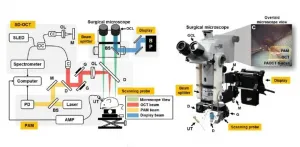(Press-News.org) BOSTON - (January 4, 2021) - As they age, people with diabetes are more likely to develop Alzheimer's disease and other cognitive disorders than are people without diabetes. Scientists at Joslin Diabetes Center now have shown that routine eye imaging can identify changes in the retina that may be associated with cognitive disorders in older people with type 1 diabetes.
These results may open up a relatively easy method for early detection of cognitive decline in this population, providing better ways to understand, diagnose and ultimately treat the decline, said George L. King, MD, Joslin's Chief Scientific Officer and senior author on a paper about the study in the Journal of Clinical Endocrinology & Metabolism.
Previous research had demonstrated an association between proliferative diabetic retinopathy (PDR, a complication of diabetes that can severely damage eyesight) and cognitive impairment in people with type 1 diabetes. "Since we knew that there were cellular changes in the retina that might reflect changes in the brain, we were interested to see whether imaging techniques that visualize those changes in the retina might be reflective of changes in cognitive functions," said Ward Fickweiler, MD, a Joslin postdoctoral fellow and first author on the paper.
The scientists drew on eye scans routinely gathered from patients as part of normal vision care at Joslin's Beetham Eye Institute. One set of scans was based on optical coherence tomography (OCT, a technique employing light to provide cross-sections of the retina). A second set of scans employed OCT angiography (OCTA, an extension of OCT technology that examines blood vessels in the retina). Both types of scans are non-invasive and widely available in eye clinics in the United States, and can be performed within minutes.
The study enlisted 129 participants in the Joslin Medalist Study, which examines outcomes among people who have had type 1 diabetes for 50 years or longer. These volunteers took a series of cognitive tests that included tasks probing memory function as well as psychomotor speed (assessing the time it took to arrange objects by hand).
Strikingly, the researchers found very strong associations between performance on memory tasks and structural changes in deep blood vessel networks in the retina. "Memory is the main cognitive task that is affected in Alzheimer's disease and cognitive decline, so that was exciting," Fickweiler said.
The Joslin team also discovered strong associations between PDR and psychomotor speed. This finding reinforced earlier outcomes that had been identified among a smaller group of Joslin Medalists, and provided details about related changes in retinal structure. Additionally, the researchers saw that PDR was associated with memory performance among the larger group of Medalists.
While these results need to be confirmed in larger clinical investigations, the routine eye exams do seem to detect the cognitive changes happening in people with diabetes, said Fickweiler.
Currently, other ways to detect conditions such as Alzheimer's disease such as MRI scans are difficult and expensive. People typically are tested only when they're showing symptoms of cognitive decline and treatments at that stage generally don't offer much help.
"If you can detect the condition at an earlier stage, when they're still asymptomatic, that may benefit patients," Fickweiler said. Earlier detection also could aid the quest to develop better therapies for neurocognitive diseases.
The Joslin team plans to launch a larger prospective study to confirm the potential of eye imaging to pick up signs of cognitive decline over time. This research will include people with type 1 diabetes who are younger and haven't had the disease for as long as the Medalists. The scientists also will analyze MRI brain images and postmortem brain samples donated by Medalists.
Additionally, the investigators will look for common mechanisms that may inflict damage on brain and retina tissues, which share much of their early embryonic development pathways. Likely suspects in people with diabetes include impaired blood vessels and high or low levels of blood glucose. The autoimmunity that drives type 1 diabetes also might inflict other forms of harm, King said.
Notably, Joslin Medalists often display relatively low levels of the complications that can afflict those with long-term type 1 diabetes. For instance, almost half of Medalists don't develop advanced eye disease, and only one of the 129 Medalists in the eye-scan study may have Alzheimer's disease. "It is possible that in the Medalists, a shared mechanism alters the progression of the early stages of retinal and brain neurodegeneration, and provides protection against both PDR and Alzheimer's disease," Fickweiler speculated.
In addition to follow-up work in type 1 diabetes, King and his team plan to perform a similar study for people with type 2 diabetes. PDR also is associated with cognitive decline in this much larger group of patients, who also get OCT and OCTA eye scans as part of their regular vision care.
INFORMATION:
The paper's co-authors include Joslin's Emily Wolfson, Samantha Paniagua, Atif Adam, Vanessa Bahnam, Konstantina Sampani, I-Hsien Wu, Gail Musen, Lloyd Aiello, Hetal Shah and Jennifer Sun. Marc Yu of Harvard Medical School also contributed.
Funding came from the Dianne Nunnally Hoppes Fund; the Beatson Pledge Fund; the National Institute of Diabetes and Digestive and Kidney Diseases; the National Eye Institute; the National Institutes of Health; JDRF; and the American Diabetes Association.
About Joslin Diabetes Center
Joslin Diabetes Center is world-renowned for its deep expertise in diabetes treatment and research. Joslin is dedicated to finding a cure for diabetes and ensuring that people with diabetes live long, healthy lives. We develop and disseminate innovative patient therapies and scientific discoveries throughout the world. Joslin is an independent, non-profit institution affiliated with Harvard Medical School, and one of only 16 NIH-designated Diabetes Research Centers in the U.S.
For more information, visit http://www.joslin.org or follow @joslindiabetes | One Joslin Place, Boston, MA 617-309-2400
To stop biodiversity loss, Canada recently committed to protecting 30% of its land and sea by 2030. But making conservation decisions about where to locate new protected areas is complicated. It depends on data both about biodiversity and about a range of benefits (e.g. freshwater, climate regulation, recreation) that people get from nature. Surprisingly, despite the size of the country, new mapping suggests that less than 1% of Canada's land (0.6% of total area or approximately 56,000 km2) is a hot spot, providing all these benefits in one place. Moreover, the study published today in Environmental Research Letters suggests that some of the most critical areas where people receive these key benefits from ...
Leipzig. The transition from the Medieval Warm Period to the Little Ice Age was apparently accompanied by severe droughts between 1302 and 1307 in Europe; this preceded the wet and cold phase of the 1310s and the resulting great famine of 1315-21. In the journal Climate of the Past, researchers from the Leibniz Institutes for the History and Culture of Eastern Europe (GWZO) and Tropospheric Research (TROPOS) write that the 1302-07 weather patterns display similarities to the 2018 weather anomaly, in which continental Europe experienced exceptional heat and drought. Both the medieval and recent weather patterns resemble the stable weather patterns that have occurred more frequently since the 1980s due to the increased warming of the Arctic. ...
A clear view of anatomical structures is vital for the success of surgery--especially in microsurgery where narrow anatomical cavities or proximity to vulnerable organs and tissues can pose significant risks to patient health. The surgical microscope has evolved to become a powerful tool for improving surgical visualization.
A END ...
TROY, N.Y. -- A loss of enzymatic processes within the body can increase a person's risk of bone fracture. This new insight was recently published in eLife by an international team of scientists and engineers led by Deepak Vashishth, the director of the Center for Biotechnology and Interdisciplinary Studies (CBIS) at Rensselaer Polytechnic Institute.
Enzymatic processes are essential to any number of chemical reactions that occur within the body, including the production of the extracellular matrix within bone that is critical for mechanical support. Phosphorylation -- one of those key enzymatic processes -- is the attachment of a phosphoryl to a protein, and is critical for ...
Worldwide, marine megafauna are at risk of extinction due to climate change, habitat loss, pollution, overhunting, population fragmentation, and hybridization with related species in areas disturbed by humans. Genetic studies can help determine the conservation status of marine animals, identifying threats to species conservation and informing interventions and policies, such as the protection of diversity hotspots or corridors for gene flow.
In a new study in Frontiers in Marine Science, researchers for the first time measured genetic diversity in manatees ...
CHAMPAIGN, Ill. -- A small portion of scientific papers are retracted for research that is in error or fraudulent. But those papers can continue to be cited by other scientists in their work, potentially passing along the misinformation from the retracted articles.
Jodi Schneider, a professor of information sciences at the University of Illinois Urbana-Champaign who studies scholarly publications and how information gets used, is considering how scientific journals can better communicate about retracted articles. In a new study published in the ...
Most of the mangrove forests on the coasts of Oman disappeared about 6,000 years ago. Until now, the reason for this was not entirely clear. A current study of the University of Bonn (Germany) now sheds light on this: It indicates that the collapse of coastal ecosystems was caused by climatic changes. In contrast, falling sea level or overuse by humans are not likely to be the reasons. The speed of the mangrove extinction was dramatic: Many of the stocks were irreversibly lost within a few decades. The results are published in the journal Quaternary Research.
Mangroves are trees that occupy a very special ecological niche: They grow in the so-called tidal range, meaning coastal areas that are ...
ALBUQUERQUE, N.M. -- If everything moved 40,000 times faster, you could eat a fresh tomato three minutes after planting a seed. You could fly from New York to L.A. in half a second. And you'd have waited in line at airport security for that flight for 30 milliseconds.
Thanks to machine learning, designing materials for new, advanced technologies could accelerate that much.
A research team at Sandia National Laboratories has successfully used machine learning -- computer algorithms that improve themselves by learning patterns in data -- to complete cumbersome materials science calculations more than 40,000 times faster than normal.
Their results, published Jan. 4 in END ...
Australian research has identified a new mechanism in which prostate cancer cells can 'switch' character and become resistant to therapy.
These findings, just published in Cell Reports, are an important development in unravelling how an aggressive subtype of prostate cancer, neuroendocrine prostate cancer (NEPC), develops after hormonal therapies.
It is well established that some tumours show increased cellular 'plasticity' in response to new or stressful conditions, such as cancer therapy, says lead researcher Associate Professor Luke Selth, from the Flinders ...
What The Study Did: Data from public health surveillance of reported COVID-19 cases and seroprevalence surveys were used in this observational study that reports an estimated 46.9 million SARS-CoV-2 infections, 28.1 million symptomatic infections, 956,174 hospitalizations and 304,915 deaths occurred in the U.S. through November 15, 2020.
Authors: Frederick J. Angulo, D.V.M., Ph.D., of Medical Development and Scientific/Clinical Affairs of Pfizer Vaccines, is the corresponding author.
To access the embargoed study: Visit our For The Media website at this link https://media.jamanetwork.com/
(doi:10.1001/jamanetworkopen.2020.33706)
Editor's ...








